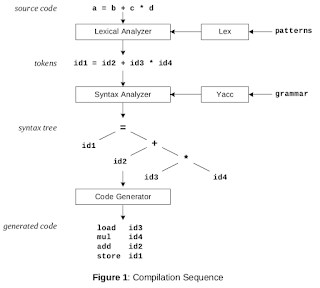13.Precedence and conflict resolution in yacc
We had seen that , when you feed yacc a grammar that is not LALR(1), it shows a warning and resolve the conflicts automatically. For a shift/reduce conflict, yacc will choose the shift. In a reduce/reduce conflict, it will reduce using the rule declared first in the file. We can control what happens by explicitly declaring precedence and associativity for operators. Rather than re-writing the grammar to implicitly control the precedence and associativity with a bunch of intermediate non-terminals, we can directly indicate the precedence so that yacc will know how to break ties. In the definitions section, we can add any number of precedence levels, one per line, from lowest to highest, and indicate the associativity (either left, right, or nonassoc). Several terminals can be on the same line to assign them equal precedence. Example: %token T_Int %left '+' %left '*' %right '^' %% E : E '+' E |E '*'...

